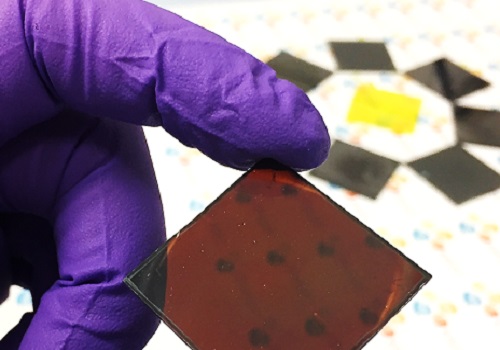A simple additive to improve film quality

Photovoltaic wafers developed for use in solar cells. The new perovskite thin films have improved structure and efficiency Copyright : © 2017 Frédéric Laquai
Thin films for use in solar cells are more effective when simple chemicals called glycol ethers are added to the film-forming mix, a KAUST team has found.
“This is an unexpected discovery,” says Esma Ugur, a PhD student in the KAUST Solar Center team that observed the effect. “It yields more uniform thin films with improved structure and efficiency.”
Perovskites are materials with the same crystal structure as the naturally occurring perovskite calcium titanium oxide. Various metal halide perovskites are proving useful for harvesting light energy that can then be used to create electric current—the basic operating principle of a solar cell. The perovskites can be added as a thin layer on top of conventional solar cells, because they can harvest the blue wavelengths of light to complement the energy of red wavelengths captured by traditional materials.
“Our aim was to improve the quality of perovskite thin films,” says Ugur. The team decided to add glycol ethers to the manufacturing process because they knew these chemicals had previously been used to help create layers of metal oxides.
By trying different glycol ether mixtures and conditions the researchers eventually gained better control over the formation of their perovskite thin films, by significantly improving the structure and alignment of the perovskite grains. This increased the reproducibility and efficiency of the perovskites so that they performed more efficiently in solar cell applications.
The procedure also operates at lower temperatures than alternatives, which is an important factor in improving cost effectiveness.
To date, the team have only made small lab-scale devices (see image). The next key challenge, explains Frédéric Laquai, who leads the KAUST Solar Center team, is to scale this up for commercial applications. To achieve this, they will need to find ways to overcome the instability of their perovskites.
“We have several groups in the KAUST Solar Center working on that issue, and on other needs for future commercial development” says Laquai. He emphasizes that perovskites are a high priority research area for the Center, with potential applications other than just solar cells. “Perovskites have many interesting optical and electronic properties, which may make them useful for applications that we have not even thought about,” he explains. Laquai also highlights the collaborative character of the projects at the KAUST Solar Center. He cites the ability to draw on the expertise of specialists from several different fields as key factors contributing to their success.
Associated links
Associated files available for download
View/download the file 'acsenergylett.7b00526.pdf
Journal information
ACS Energy Lette
Media Contact
All latest news from the category: Power and Electrical Engineering
This topic covers issues related to energy generation, conversion, transportation and consumption and how the industry is addressing the challenge of energy efficiency in general.
innovations-report provides in-depth and informative reports and articles on subjects ranging from wind energy, fuel cell technology, solar energy, geothermal energy, petroleum, gas, nuclear engineering, alternative energy and energy efficiency to fusion, hydrogen and superconductor technologies.
Newest articles

A universal framework for spatial biology
SpatialData is a freely accessible tool to unify and integrate data from different omics technologies accounting for spatial information, which can provide holistic insights into health and disease. Biological processes…

How complex biological processes arise
A $20 million grant from the U.S. National Science Foundation (NSF) will support the establishment and operation of the National Synthesis Center for Emergence in the Molecular and Cellular Sciences (NCEMS) at…

Airborne single-photon lidar system achieves high-resolution 3D imaging
Compact, low-power system opens doors for photon-efficient drone and satellite-based environmental monitoring and mapping. Researchers have developed a compact and lightweight single-photon airborne lidar system that can acquire high-resolution 3D…





















